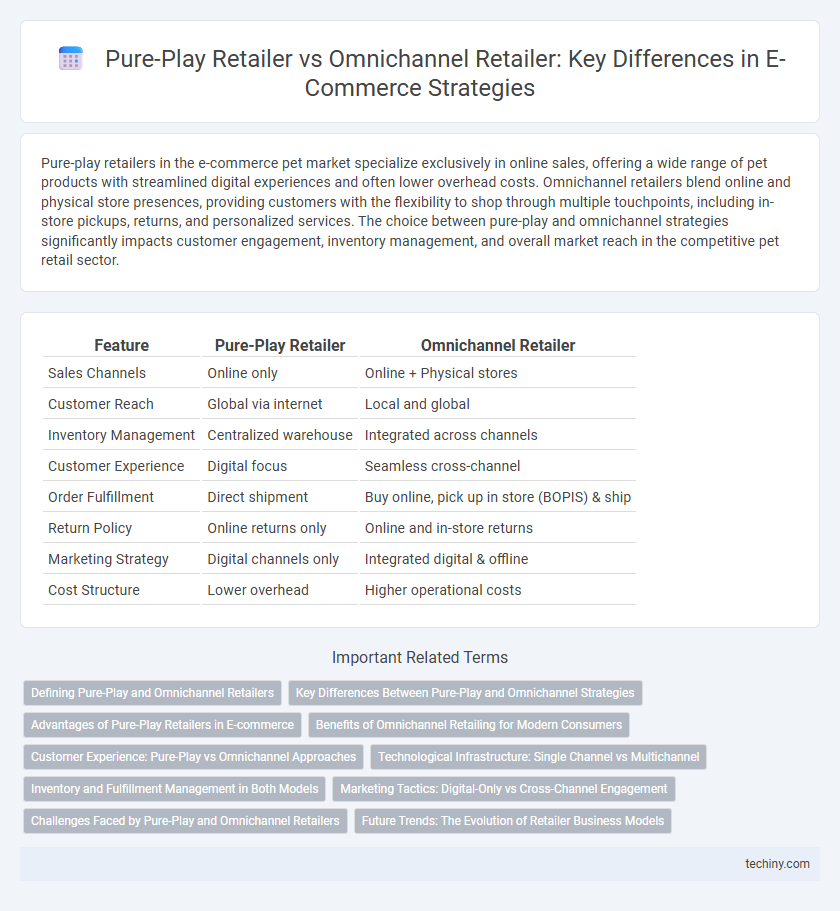Pure-play retailers in the e-commerce pet market specialize exclusively in online sales, offering a wide range of pet products with streamlined digital experiences and often lower overhead costs. Omnichannel retailers blend online and physical store presences, providing customers with the flexibility to shop through multiple touchpoints, including in-store pickups, returns, and personalized services. The choice between pure-play and omnichannel strategies significantly impacts customer engagement, inventory management, and overall market reach in the competitive pet retail sector.
Table of Comparison
| Feature | Pure-Play Retailer | Omnichannel Retailer |
|---|---|---|
| Sales Channels | Online only | Online + Physical stores |
| Customer Reach | Global via internet | Local and global |
| Inventory Management | Centralized warehouse | Integrated across channels |
| Customer Experience | Digital focus | Seamless cross-channel |
| Order Fulfillment | Direct shipment | Buy online, pick up in store (BOPIS) & ship |
| Return Policy | Online returns only | Online and in-store returns |
| Marketing Strategy | Digital channels only | Integrated digital & offline |
| Cost Structure | Lower overhead | Higher operational costs |
Defining Pure-Play and Omnichannel Retailers
Pure-play retailers operate exclusively online, leveraging digital platforms to offer a wide range of products without physical store presence, which reduces overhead costs and enhances scalability. Omnichannel retailers integrate various sales channels, including physical stores, online marketplaces, and mobile apps, providing a seamless customer experience across touchpoints. The distinction lies in pure-play retailers' focus on digital-only strategies versus omnichannel retailers' emphasis on a cohesive and unified shopping journey.
Key Differences Between Pure-Play and Omnichannel Strategies
Pure-play retailers operate exclusively online, leveraging e-commerce platforms to reduce overhead costs and focus on digital marketing, while omnichannel retailers integrate both online and offline channels to create a seamless customer experience. Pure-play strategies prioritize agility and scalability, utilizing data analytics to optimize online sales, whereas omnichannel approaches emphasize consistent branding and personalized engagement across multiple touchpoints, including physical stores, mobile apps, and social media. The key difference lies in channel integration, with omnichannel retailers investing heavily in inventory synchronization, customer service, and unified commerce systems to enhance shopper convenience and loyalty.
Advantages of Pure-Play Retailers in E-commerce
Pure-play retailers in e-commerce benefit from lower operational costs due to their exclusive online presence, enabling competitive pricing and higher profit margins. They can rapidly adapt to market trends and customer preferences through agile digital strategies, enhancing user experience and personalization. Pure-play models also leverage focused brand positioning and efficient inventory management, driving scalability and streamlined supply chain operations.
Benefits of Omnichannel Retailing for Modern Consumers
Omnichannel retailing offers modern consumers seamless shopping experiences by integrating online, mobile, and in-store channels, enhancing convenience and accessibility. It provides personalized interactions and consistent product availability, increasing customer satisfaction and loyalty. Real-time inventory synchronization in omnichannel retail ensures faster delivery options and flexible returns, meeting the expectations of today's digital-savvy shoppers.
Customer Experience: Pure-Play vs Omnichannel Approaches
Pure-play retailers focus exclusively on online platforms, offering seamless digital interfaces and personalized browsing experiences optimized by data analytics to enhance customer convenience and speed. Omnichannel retailers integrate physical stores with online channels, providing customers consistent touchpoints, such as in-store pickups, real-time inventory updates, and unified loyalty programs that bridge digital and offline interactions. This blended approach often results in higher customer satisfaction and retention by catering to diverse shopping preferences and ensuring frictionless transitions across multiple channels.
Technological Infrastructure: Single Channel vs Multichannel
Pure-play retailers rely on a single, robust e-commerce platform optimized for seamless online transactions, efficient inventory management, and data analytics specifically tailored to digital consumer behavior. Omnichannel retailers integrate multiple technological infrastructures, combining online platforms with physical store systems to provide unified inventory visibility, real-time customer data synchronization, and consistent shopping experiences across channels. The complexity of omnichannel systems demands advanced middleware solutions and APIs to enable seamless communication between various sales and fulfillment channels, enhancing both operational efficiency and customer satisfaction.
Inventory and Fulfillment Management in Both Models
Pure-play retailers rely exclusively on online inventory systems and centralized fulfillment centers, enabling streamlined stock management but limited real-time in-store availability. Omnichannel retailers integrate inventory data across physical and digital channels, allowing dynamic stock allocation and flexible fulfillment options such as buy-online-pickup-in-store (BOPIS) and ship-from-store. Effective inventory synchronization in omnichannel models enhances customer satisfaction by reducing stockouts and expediting order fulfillment compared to pure-play operations.
Marketing Tactics: Digital-Only vs Cross-Channel Engagement
Pure-play retailers leverage digital-only marketing tactics such as targeted social media ads, search engine optimization (SEO), and personalized email campaigns to drive online sales efficiently. Omnichannel retailers utilize cross-channel engagement strategies that integrate in-store promotions, mobile app notifications, and online content marketing, creating a seamless customer experience across multiple touchpoints. Data analytics and customer behavior tracking are crucial for both models to optimize marketing spend and improve conversion rates.
Challenges Faced by Pure-Play and Omnichannel Retailers
Pure-play e-commerce retailers often struggle with limited customer touchpoints and lack of physical presence, leading to challenges in building brand trust and handling complex logistics efficiently. Omnichannel retailers face difficulties in integrating inventory systems and providing a seamless customer experience across online and offline channels, resulting in higher operational costs and potential service inconsistencies. Both models must address challenges related to data management, customer engagement, and adapting to evolving consumer expectations in a competitive digital marketplace.
Future Trends: The Evolution of Retailer Business Models
Pure-play retailers are increasingly integrating advanced digital technologies such as AI-driven personalization and augmented reality to enhance the online shopping experience and meet evolving customer expectations. Omnichannel retailers invest heavily in seamless cross-channel experiences, including unified inventory management and click-and-collect services, to strengthen customer loyalty and operational efficiency. Future trends in retail emphasize hybrid models that combine the agility of pure-play e-commerce with the comprehensive physical presence of omnichannel strategies, driven by data analytics and real-time consumer insights.
pure-play retailer vs omnichannel retailer Infographic

 techiny.com
techiny.com